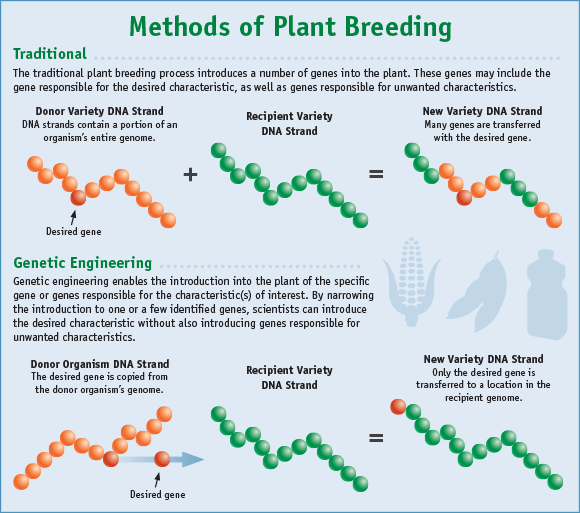When I asked what topics you were interested in learning more about for an upcoming Tuesday Tip post…I received a few requests for information about GMOs.
GMOs stands for Genetically Modified Organisms.
I am not an expert on GMOs but I asked my colleague, dietitian Nicole Cormier, who is better versed in this topic to give us all a helping hand and explain a bit more about this controversial subject.  Here’s Nicole’s recap for those of you who are interested to learn a bit more about GMOs:
Here’s Nicole’s recap for those of you who are interested to learn a bit more about GMOs:
According to the “Non GMO Project”, it is estimated that about 80% of processed foods in America contain GMOs.
So what exactly are GMOs?
GMOs or Genetically Modified Organisms are plants or animals whose genes have been intentionally altered to produce a desired effect. Creating GMOs is an experimental biotechnology that involves merging DNA from different species and creating combinations of plant, animal, bacterial and viral genes that likely would not occur naturally.
Photo credit: fda.gov
Where might we find GMOs in our foods?
Some key crops that are currently being genetically engineered for human consumption include: soybeans, corn, tomatoes, canola, cottonseed, sugar beets, Hawaiian papaya, and some zucchini and yellow squash.
There are no labeling laws in place in the US to say if a food has been genetically altered or not. Some foods have volunteered to be part of the GMO project which provides a verified seal on non GMO food. Per the Non GMO Project website:
“What does ‘Non-GMO Project Verified seal’ mean? The verification seal indicates that the product bearing the seal has gone through our verification process. Our verification is an assurance that a product has been produced according to consensus-based best practices for GMO avoidance:
- We require ongoing testing of all at-risk ingredients—any ingredient being grown commercially in GMO form must be tested prior to use in a verified product.
- We use an Action Threshold of 0.9%. This is in alignment with laws in the European Union (where any product containing more than 0.9% GMO must be labeled). Absence of all GMOs is the target for all Non-GMO Project Standard compliant products. Continuous improvement practices toward achieving this goal must be part of the Participant’s quality management systems.
- After the test, we require rigorous traceability and segregation practices to be followed in order to ensure ingredient integrity through to the finished product.
- For low-risk ingredients, we conduct a thorough review of ingredient specification sheets to determine absence of GMO risk.
Verification is maintained through an annual audit, along with onsite inspections for high-risk products.” Look for this seal:
Corn and soybeans are pervasive ingredients in processed food products throughout our supermarkets. There has been a growing amount of scientific evidence has shown that GMOs could potentially be harmful to humans, including our gastrointestinal tracts. You can find a detailed non-GMO Shopping Guide just click here! The research in this area is limited, however, as studying the impact of food changes that are abundant in the food supply is difficult to sort out.
GMOs are not currently required to be listed on food labels in the US. Many other countries, 64 to be exact, have already enforced GMO labeling on products, or even banned GMOs altogether.
This past year, the Massachusetts GMO labeling bill has been at the forefront of legislature’s attention. Even though nearly half of the legislature has officially endorsed GMO, it was not passed. MA Right to Know GMO will be working on having another bill created for next year.
A big thanks to Nicole for filling us in on some GMO basics. If you’d like to learn more about Nicole’s practice and interests..then please visit her webiste here. She has the cutest bike logo on her site.
A few more GMO resources should you care to learn a bit more:
A good recap on GMOs here!
Food and Drug Administration review on GMOs
The purpose of this post is to inform not add fear. This biotechnology has been around for 20 years. From my perspective, less is more. I don’t fear every bite of food I take…but I try to purchase non GMO foods when possible.
Next post will include a recap on the probiotic symposium I attended last week! And some news from Monash University coming next week. Stay tuned!
I hope you are all having a wonderful week!

Wendy
I am ready to start the elimination phase. What foods are best to introduce back into my diet? How soon is it best to reintroduce gluten?
zoe
Thanks for the post!
I am a volunteer with the Yes on 92 campaign – Oregon Right to Know – a measure to label genetically engineered foods on the ballot in Oregon this November.
For more information on GMO’s check out: Genetic Roulette (book and film) by Jeffrey Smith from the Institute for Responsible Technology or the IRT website, Other websites: Organic Consumers Association, Food Democracy Now! Cornucopia Institute, Center for Food Safety or Oregon Right to Know -Yes on 92
zoe
BTW – Certified organic food never contains GMO’s. Buying organic or non GMO project certified are currently the only ways to ensure your food is not genetically altered.